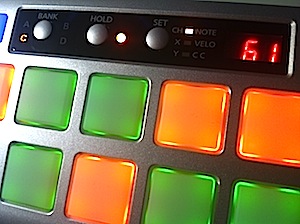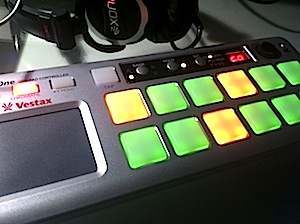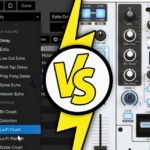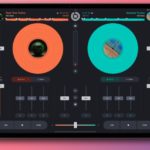Video Review
One obvious addition to your DJ set-up is a pad controller of some kind. By “pad” I mean pads or buttons – anything you can hit, basically, in order to control cue points, looping, effects, samples, scenes and so on in a more expressive way than by pressing limited, cramped little buttons on your DJ controller.
Such controllers come in all shapes and sizes, from the innovative little Dicers to the boutique Midi Fighter, to all singin’, all dancin’ grids for Ableton like the Launchpad and the Akai APC series. But they all offer the same type of function to DJs.
Vestax has entered the crowded fray with a DJ pad controller that sits closest alongside the likes of the Akai LPD8 – a slimline controller with several pads and a few other features. So let’s take a closer look.
It’s gotta be Midi
First things first if you’re thinking of adding such a controller to your set-up – these types of controllers are Midi devices, which means your DJing software has to be able to work with Midi. That’s not going to present any problems to you if you use Traktor, or Virtual DJ, or Ableton Live… but if you use Serato ITCH, you’re stuck – your hardware and software are mapped function-to-function and you can’t add anything that isn’t official ITCH hardware. Just so you know.
First impressions and setting up
Vestax doesn’t make cheapo gear, but the PAD-One is, even by their standards, a solid hunk of a controller, made in thick aluminium that would make even a MacBook Pro look flimsy. Heavy and sturdy, it is built to withstand abuse. It’s long and slim, with 12 square rubberised pads, a small trackpad (X/Y controller pad) on the left, and a few other buttons for settings, modes and Midi configuration.
In and out, it has a mini Midi jack for controlling other Midi devices (there’s an adaptor in the box), a USB out (again, a cable provided) and an optional mains power jack (no transformer provided, as it’s meant to run off USB bus power and, in practically all cases, it will run just fine like that).
Once plugged in, the pads glow green, turning yellow when pressed, which is a feature that will be familiar to users of Ableton Live controllers like the Akais or the Novation Launchpad.

Small yellow letters surround the Bank button to tell you if you’ve selected banks A, B, C or D for the pads (so it has four 12-pad banks giving you 48 in total), and there’s also a three-digit red LED readout that’s used to tell you the BPM you’ve tapped (more later), and to indicate Midi channels and number when configuring. The overall impression is of an attractive and professional controller, that I could happily see myself performing in a club using.
To set it up, you plug it in and both Windows and Mac will automatically recognise it and, in the case of Windows, the correct drivers will be installed. Now it’s just a case of assigning functions to buttons in your DJ software, using whatever learning or mapping facility is provided to you or using any pre-existing mappings you have or can find.
It took me all of 30 seconds to start mapping it to functions in Virtual DJ, although funnily enough, Virtual DJ recognised it but the mapping in my software wasn’t good and didn’t seem to do what the software said it should.
In use
First, it’s worth mentioning that this is a “proper” pad controller as opposed to a box of buttons – the pads are velocity sensitive, so the harder you hit them, the higher the velocity Midi number the unit sends to software. If you’re using it to trigger loops, cues etc this isn’t going to matter to you, but with the right mapping, this could be used to control volume of samples, for instance – particularly useful if you’re using percussion samples.
So – once set up and mapped, and of course, depending on what you decide to use it for, it has a number of intuitive features fine-tuned for live performance. A big bonus of this device is that you can make Midi changes without resorting to set-up software; indeed, no set-up software exists for it.

By hitting a small “edit” button, the unit enters config mode. Even in this mode, it still “works” – the pads still do what they’re meant to. But now, you can hit a pad and set Midi note, velocity or control change (CC) by using the “set” button and the rotary to the right of the unit. Hit “edit” again, and the pad retains its new value. It really couldn’t be simpler.
You can change the Midi channel of each bank by pressing “bank” to select the channel and altering the Midi channel using the knob in exactly the same way, so there’s lots of performance flexibility here.
There is a “hold” button which when activated means that the pads will continue to send Midi messages until pressed again. The fact that the pads change from green to yellow when Midi is being sent comes into its own here, as when you are using it to control loops, for instance, at a glance you can see what’s set and what isn’t.
Further features
To the left of the unit is the X/Y pad with associated Roll and Chromatic features. The Roll feature is powerful. It basically plays a sample continuously to a tapped-out tempo (you tap on the “TAP” button and the tempo displays on the LED). When ROLL is on and you trigger a pad while touching the X/Y pad, that sample loops to the tempo selected.

By using the XY HOLD button too, you don’t need to touch the X/Y pad, so samples will continue to loop. Turn the XY HOLD off, and those samples carry on looping, but now you have your one-touch pads available again, so you can drop in one-shot samples over the simple rhythm track you just created.
Chromatic offers the effect of halving a loop length repeatedly, so beloved of digital DJs everywhere. By moving your finger on the pad from left to right, the set tempo is split from 1, through 1/2, 1/4 etc to 1/32nd. The Y axis, meanwhile, controls volume.
Finally, you can assign X and Y axis parameters in Midi same as anything else, so you can use the pad to control effects etc just as easily for your pads.
Conclusion
This unit is fairly, squarely and without compromise designed for performers. It is built to withstand life on the road and would be a joy to use in dark places due to the clear, colourful readouts from all functions.
Not only that, but because it can easily be configured on the fly and without recourse to any software, and because it has clever features that allow you to mix and match sample playback modes (namely looping and one-shot) to build up simple rhythms on the fly, it manages to be both simple to use and powerful.
Because you tap out the BPM manually, it can’t slave-sync with your DJ software (as far as I can tell – I’m no Midi expert so in the right hands this may be possible), and because you tap out the BPM rather than dial it in, you can’t set your DJ software to 125 and then set this to 125 knowing they’ll then be, to all intents and purposes “locked”.

But if you know how to build up sample loops on the fly I would expect you to be able to make the necessary tweaks to your performance to hold two elements in time manually anyway, so I don’t see this as a big issue.
Point is that the PAD-One isn’t designed for sterile, unchanging, cold-pristine performances – it’s designed to be hooked up to a pile of juicy samples, or connected to some great cue points in a track, or tied to your favourite effects, and then royally bashed to make exciting, spontaneous additions to your DJ sets. For DJs for whom this sounds like fun, the Vestax PAD-One – while not particularly cheap – will reward you grandly. It’s well thought out, beautifully built, and child’s play to use. We can thoroughly recommend it to you.
Are you in the market for a pad controller? Which one are you saving for? Has this review swayed you in any direction? Please let us know your thoughts in the comments.








